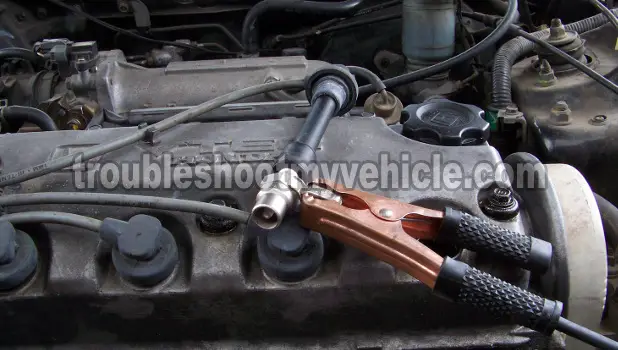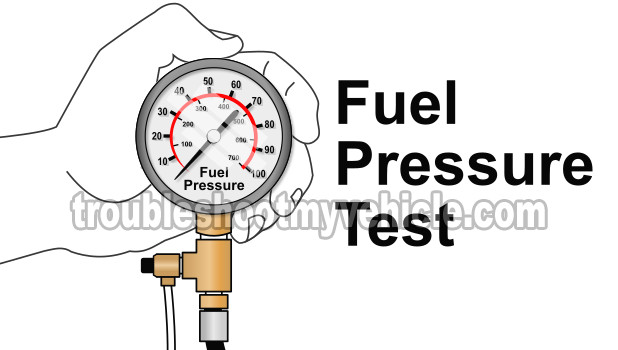
Quite a few things can cause your 1.6L Honda Civic (Civic del Sol) to crank but not start. For example: a bad fuel pump, a bad igniter (ignition control module), a bad ignition coil, a busted timing belt and the list goes on.
The good news is that troubleshooting the no-start condition of your Honda Civic is not that difficult. With a solid diagnostic strategy, you can do it yourself and replace the failed part, whichever it may be. In this article, I'll show you the basics of testing/troubleshooting such a problem.
Contents of this tutorial:
![]() You can find this tutorial in Spanish here: Cómo Probar Un Arranca Pero No Prende (1995-2000 1.6L Honda Civic) (at: autotecnico-online.com).
You can find this tutorial in Spanish here: Cómo Probar Un Arranca Pero No Prende (1995-2000 1.6L Honda Civic) (at: autotecnico-online.com).
APPLIES TO: This tutorial applies to the following vehicles:
- 1.6L Honda Civic: 1995, 1996, 1997, 1998, 1999, 2000.
Difference Between A No Start And A No Crank Condition
There's a world of difference between a no-crank and a no-start condition. Here's a brief description:
Cranks but does not start condition: Means that your Honda's starter motor is cranking the engine, but the engine isn't starting due to a fuel delivery issue, an ignition system fault, or an engine mechanical problem.
Does not crank condition: Means the engine isn't cranking when you turn the key to start it. In other words, the engine doesn't turn over at all. This is usually due to a discharged/bad battery, bad starter motor, bad ignition switch, bad neutral safety switch, or a locked-up engine.
If the engine in your 1.6L Honda Civic doesn't crank, your next step is to make sure you've got a fully charged battery. If the battery is discharged, then you've got to charge it up, and once it's charged, you need to check the alternator to make sure it's charging the battery.
Now, if the battery is OK (as in, it isn't completely discharged and behind the no-crank), your next step is to check the starter motor. A bad starter motor will not crank the engine over. The following two tutorials will help you test the alternator and the starter motor:
- How To Test The Alternator (1996-2000 1.6L Honda Civic).
- How To Test The Starter Motor (1996-2000 1.6L Honda Civic).
No Start Condition Basics
The key to troubleshooting the no-start condition of your 1.6L Honda Civic, is to know that the engine needs 3 things to start and run. These are:
- Air.
- Fuel.
- Spark.
When your Honda Civic (Civic del Sol) cranks but does not start it's because one of these 3 things is missing from the mix.
So, the idea behind any diagnostic, trying to figure out why the car won't start, is to perform tests on the fuel system, the ignition system, an the engine mechanical system.
Once you've found out what system is the one not providing one of the three things the engine needs, the next step is to test specific components within that system. To go into more details, the three main areas where the problem will reside in and that you should concentrate on when facing a no-start condition are:
1.) Ignition System
- The ignition system is the one responsible for creating and delivering spark. Without spark, the engine will crank but not start.
- The ignition system of the Honda vehicles covered by this article use a distributor type system.
- In my experience, the most common component failures, of the ignition system that cause a no-start no-spark condition are:
- Ignition control module (ICM) -most commonly known as the igniter.
- Ignition coil.
- Distributor cap.
- Distributor rotor.
- All of the above ignition system components can be tested in a methodical way to find out exactly what has failed (if indeed something has).
2.) Fuel System
- The fuel system is the one responsible with supplying the engine with fuel.
- The fuel system component that causes the majority of 'no-start no-fuel' problems:
- Main relay (this is the relay that supplies the fuel pump and fuel injection computer with power).
- Fuel pump.
- The fuel pump can be tested to make sure it has really fried.
3.) Engine Mechanical System
- The engine pistons and cylinder head valves (and all the other related components like: timing belts, etc.) are the ones responsible for the induction of the fresh air the engine needs for the combustion process.
- Although rare, internal engine mechanical problems can and do cause no-start conditions.
- Possible internal engine problems are:
- Blown head gasket.
- Blown engine.
- Broken timing belt.
OK, the list of possible things that can go wrong looks pretty long but it is rare to see (or have) two different components go bad from two separate systems at the same time.
The cool thing is, is that there is a diagnostic strategy that you can use to figure out exactly what's wrong with your particular no-start problem. Let's find out more about it in the next subheading.
No Start 1: Checking For Spark

I've found that most of the 'cranks but does not start' problems I've diagnosed and repaired on Honda Civics, have had their root cause in the ignition system. Specifically the ignition system is not creating spark.
So, my recommendation to you, is to test each spark plug wire with a dedicated spark tester. If the ignition system is the cause of the no-start, you're not gonna' see spark at any of the 4 spark plug wires.
Testing the ignition system on your Honda isn't hard or difficult. I've written a tutorial that'll show you in a step-by-step manner and you can find it here: How To Test The Igniter, Ignition Coil Accord, Civic, CRV, and Odyssey (at: easyautodiagnostics.com).
Remember, the idea behind checking for spark is to see if all of the 4 engine cylinders are getting spark. Here are the most common causes of a no-spark result:
CASE 1: Spark was present in all 4 cylinders. This result tells you three very important things: 1.) the crank sensors (there are 3 inside the distributor) are functioning correctly, 2.) the ignition control module (also known as the igniter) is OK, and 3.) the ignition coil is good. You don't have to spend any time testing them or any money replacing them.
Your next step is to verify fuel pressure. Go to: No Start 2: Checking For Fuel.
CASE 2: Spark was NOT present in all of the cylinders. This test result tells you without a doubt that the no-start condition of your 1.6L Honda Civic (Civic del Sol) is due to a malfunction in the ignition system.
Now, with no spark in any of the engine cylinders, this what I would suggest:
- Check for spark directly on the ignition coil tower using a spark tester.
- This is the best way to test the distributor cap. The distributor cap and rotor are infamous for causing no spark no-start conditions.
- If you do get spark coming out of the ignition coil tower, you now know beyond a shadow of a doubt the distributor cap and rotor must be replaced.
- You can find a complete ignition system diagnostic procedure here: How To Test The Igniter, Ignition Coil Accord, Civic, CRV, and Odyssey (at: easyautodiagnostics.com).
- Test the ignition coil and ignition control module (igniter).
- If no spark is firing from the ignition coil, then the next step is to verify that the ignition control (igniter) is activating it. This is a pretty simple test.
- You can find the ignition coil and ignition control module (igniter) test here: How To Test The Igniter, Ignition Coil Accord, Civic, CRV, and Odyssey (at: easyautodiagnostics.com).
- Check that the timing belt is not broken.
- A broken timing belt will cause a no spark no-start condition.
- You can find the broken timing belt test here: How To Test For A Broken Timing Belt (1995-2000 1.6L Honda Civic).
No Start 2: Checking For Fuel

After confirming that the ignition system is creating and delivering spark to each cylinder, the next step is to test the fuel system, mainly the fuel pump.
A bad fuel pump will cause your 1.6L Honda Civic (Civic del Sol) to crank but not start since the fuel pump is the one responsible for supplying fuel to the fuel injectors.
One method that I've used to test for a lack of fuel (and the one you'll probably have to use) is spraying starting fluid into the throttle body and then having a helper crank the engine. If the engine starts then I now know that I need to take a closer look at the fuel pump to see if it's fried or not.
The absolute best way to test the fuel pump is with a fuel pressure gauge. Using any other method is not as accurate. The cool thing is that fuel pressure test gauges with the adapter needed to test the fuel pressure on Honda cars have come down in price a lot!
A fuel pressure gauge can be connected to your 1.6L Civic's fuel system to check for a bad fuel pump. The fuel pressure test gauge is connected to one of the fuel filter's banjo bolts with a fuel pressure test adapter. This adapter must have a 1.0mm thread pitch and is usually labeled as: Honda M8x1.0 banjo bolt (or Import M8x1.0) adapter. Here's the guide I've written that'll show you how:
When testing the fuel pump (with a fuel pressure gauge), you'll usually see one of two results:
CASE 1: Fuel pressure is at specification. Not only does this result tell you that the fuel pump is OK but that the following components, that supply the fuel pump with power, are OK too:
- Fuel pump fuse.
- Fuel pump relay (which is known as the Main Relay).
And so, there's no need to spend time testing them or money replacing them. Your next step is to check the engine's internal health: No Start 3: Checking Engine Mechanical Condition.
CASE 2: Fuel pressure is not present. This usually means that the pump has failed, but not always. I would recommend testing/checking the following before condemning the fuel pump:
- After verifying that no fuel pressure exists, check that the fuel pump is getting power by tapping into the power circuit that feeds the pump with 12 Volts with a multimeter.
- Once you're tapped in, have a helper crank the engine while you observe your multimeter in Volts DC mode. If voltage is present (12 Volts), then you have confirmed that the fuel pump fuse and fuel pump relay are working perfectly.
- Confirming power to the fuel pump (with a multimeter) also verifies that the fuel pump has failed and needs to be replaced.
- If no voltage is present, as your helper cranks the engine, then the cause of no fuel condition is due to either a bad fuse, fuel pump relay (known as the Main Relay).
No Start 3: Checking Engine Mechanical Condition

One of the most overlooked areas, when testing a hard to diagnose no-start, is the mechanical condition of your 1.6L Honda vehicle.
Checking the engine mechanical condition means an engine compression test and the timing belt.
- When performing an engine compression test, what you're looking for is an average compression reading of NO LESS THAN 90 PSI across all or the majority of the engine cylinders.
- If you have one or just two readings that are under 90 PSI your Honda vehicle will still start and run, albeit with a misfire condition.
- The following tutorial will help you do a compression test:
- The following tutorial will help you do a timing belt test:
- The following tutorial will help you check for a blown head gasket:
No Start Troubleshooting Summary
In this article/tutorial, you've learned that checking the basics (spark, fuel and air -engine compression) is the key to successfully troubleshooting and repairing the cause of the Cranks but Does Not Start Condition on your Honda Civic (Civic del Sol).
I'll emphasize this one more time: The key to saving yourself time and money is checking the basics first. The basics are spark, fuel and air (engine cylinder compression).
To check the basics, you need tools. There's just no way around it. One of the analogies that I've always enjoyed repeating, about doing a job without the right tools is like trying to eat a bowl of soup with a fork.
So besides knowing what to test, you need tools to do those tests. You don't have to spend an arm and a leg, since you can buy a lot of diagnostics tools that are tailored for the pocket-books of the serious do-it-yourself-er. Here are some of the basic tools you'll need:
- Fuel pressure gauge.
- Spark tester.
- Compression gauge.
- Multimeter.
More 1.6L Honda Civic Tutorials
You can find a complete list of tutorials here: 1.6L Honda Civic Index Of Articles. Below, is a sample of articles you'll find in this index of articles:
- How To Test: Lock-up Control Solenoid Valves (1996-2000 1.6L Honda Civic).
- How To Test The Throttle Position Sensor (1995-2000 1.6L Honda Civic).
- How To Test Engine Compression (1995-2000 1.6L Honda Civic).
- How To Test For A Broken Timing Belt (1995-2000 1.6L Honda Civic).
- How To Test The Igniter, Ignition Coil Accord, Civic, CRV, and Odyssey (at: easyautodiagnostics.com).

If this info saved the day, buy me a beer!


